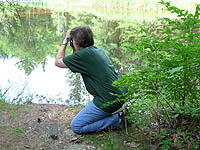What Is Pastel?
So, why exactly are pastels so special?
Just go to any summer outdoor art festival, and, if you see someone painting in pastel, you will also overhear someone saying, “Oh, look, that lady (or guy) is drawing with chalk! Isn’t that what they use in school on the blackboard?” Not so!!
All pigments used in painting are the same, whether the artwork is created in oil, acrylic, watercolor or pastel. All artist quality paint begins with a dry pigment. To the dry, powdery pigment is added a binder along with the oil, acrylic or water, and a “paint” is created. Regardless of the medium, the same dry pigments are utilized.
Why are the colors so bright, you ask, if the paint is called a “pastel”. In the vernacular, the secondary meaning of the word ‘pastel’, according to Webster, signifies a pale, light color or any of a variety of pale and light colors. However, the primary meaning of the word, as derived from the Italian word “pastello”, means a paste made of ground color (dry pigment). This also describes the medium we know today as pastel.
Pastels are created by grounding the pigment, adding a binder and a little water to hold the powder together. A paste is created which is rolled into sticks and allowed to dry. Artist’s pastels vary in density from hard to a soft, buttery consistency. Many artists use a combination of hard and soft pastels to achieve the luminosity and brilliance so typical of the medium.
In the middle of the last century, many pastels were fugitive, meaning that the dyes used in the making of the pigments were not stable and were subject to fading when exposed to ultraviolet light. Today, modern pastels are the most permanent of all media and the most durable if the painting is properly protected by framing under glass in an archival manner. Oils and acrylics are prone to cracking, yellowing with age, but pastels endure without the need for restoration. A rebirth in the popularity of this traditional medium is underway.
Short History of Pastel
As a medium, the creation of art in pastel has been around since the dawn of mankind. Early cave drawings using earth pigments remain today as testament to man’s need to document life around him. Leonardo da Vinci first mentioned pastel in 1495.
During the early 1700’s, Parisian artist Rosalba Carriera became the first master of the medium. In the 19th century a resurgence of pastel painting was led by Manet, Monet, Pissarro and others.
By mid-century Edgar Degas popularized the medium and greatly advanced pastel’s total range of effects through experimentation. Then followed American artists, Ruth Henshaw, James Whistler, Mary Cassatt and others.

